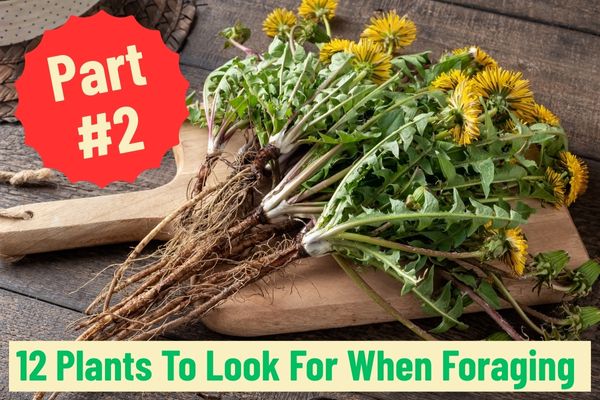Disclaimer: Always consult with healthcare professionals before using wild plants medicinally. Proper plant identification is crucial – when in doubt, don’t consume. Start with small amounts to test for allergic reactions.
Recap: Building Your Wild Plant Knowledge
In Part 1, we explored twelve wild plants foundational to beginning & seasoned foragers like.
Let’s continue to expand our knowledge with more specialized plants that offer unique nutritional and medicinal benefits.
13. Chicory (Cichorium intybus)
Identification:
A perennial herb with bright blue flowers (occasionally pink or white) along rigid, branched stems.
Leaves are deeply lobed at the base, becoming smaller up the stem.
Contains milky latex.
Nutritional Benefits:
Leaves provide vitamins A and C, potassium, and calcium.
Roots contain inulin, beneficial for gut health and blood sugar regulation.
Medicinal Properties:
Traditionally used for liver support and digestive health.
Inulin acts as a prebiotic, feeding beneficial gut bacteria.
May help lower blood sugar levels.
Foraging:
Common along roadsides, fields, and waste areas.
Harvest young leaves in spring before they become too bitter.
Dig roots in fall.
Preparation:
Young leaves are good in salads mixed with milder greens.
Roots can be roasted and ground as a coffee substitute or dried for medicinal tea.
14. Cattail (Typha latifolia)
Identification:
Tall marsh plants have long, flat, sword-like leaves and distinctive brown, sausage-shaped flower spikes.
Grows 3-9 feet tall in wetland areas.
Nutritional Benefits:
Often called “supermarket of the swamp” – roots contain carbohydrates similar to potatoes, shoots are rich in vitamins A and C, and pollen is protein-rich.
Medicinal Properties:
Roots have traditionally been used for wound healing and burns.
The gel from roots has soothing properties for skin irritation.
Foraging:
Found in marshes, pond edges, and wet ditches.
Spring shoots, summer pollen, fall roots, and winter stored starch in roots are all edible.
Preparation:
Young shoots peel like corn husks to reveal tender white interiors.
Collect pollen by shaking flower heads into bags.
Roots can be dried and ground into flour or processed fresh for starch.
15. Lamb’s Quarters (Chenopodium album)
Identification:
Annual plant with diamond-shaped, toothed leaves that often have a white, mealy coating underneath.
Tiny green flowers appear in dense clusters.
Can grow 1-6 feet tall.
Nutritional Benefits:
Leaves contain more nutrition than spinach, with exceptional amounts of vitamins A and C, calcium, iron, and protein.
Medicinal Properties:
High nitrate content supports cardiovascular health.
Contains compounds that may help regulate blood pressure.
Foraging:
Common in gardens, fields, and disturbed areas.
Harvest young leaves and shoots throughout the growing season.
Seeds are also edible when mature.
Preparation:
Young leaves are excellent raw or cooked like spinach.
Seeds can be ground into flour or cooked as porridge.
Remove any bitter or tough stems before preparation.
16. Amaranth (Amaranthus species)
Identification:
Tall annual plants (2-8 feet) with broad, alternate leaves and dense clusters of tiny flowers in upright or drooping spikes.
Leaves may be green or reddish-purple. Seeds are tiny, round, and numerous.
Nutritional Benefits:
Seeds contain complete protein with all essential amino acids, plus iron, calcium, and B vitamins.
Leaves are rich in vitamins A and C, calcium, and protein.
Medicinal Properties:
High lysine content supports tissue repair.
Anti-inflammatory compounds may help reduce cholesterol levels.
Traditionally used for diarrhea and excessive menstruation.
Foraging:
Common in gardens, fields, and disturbed soils.
Harvest young leaves throughout summer.
Collect seeds in fall by shaking mature flower heads into containers.
Preparation:
Young leaves cook like spinach.
Seeds can be popped like tiny popcorn, ground into flour, or cooked as porridge.
Thoroughly clean seeds by winnowing to remove chaff.
17. Fireweed (Chamaenerion angustifolium)
Identification:
Tall perennial (2-8 feet) with narrow, lance-shaped leaves arranged alternately.
Showy spikes of four-petaled magenta flowers bloom from bottom to top.
Produces fluffy white seeds.
Nutritional Benefits:
Young leaves are exceptionally high in vitamins A and C, plus calcium and iron.
Contains more vitamin C than oranges.
Medicinal Properties:
Traditionally used for digestive issues and prostate health.
Anti-inflammatory compounds may help with respiratory conditions.
Foraging:
Common in burned areas, clearings, and roadsides in northern regions.
Harvest young leaves before flowering. Inner pith of stems is also edible.
Preparation:
Young leaves make excellent tea or can be cooked like spinach.
Inner stem pith can be eaten raw or cooked. Flowers are edible and make colorful garnishes.
18. Chickweed (Stellaria media)
Identification:
Low-growing annual with small, oval leaves arranged oppositely on weak, trailing stems.
Tiny white flowers with five deeply notched petals that appear to be ten petals.
Single line of hairs along one side of the stem.
Nutritional Benefits:
Rich in vitamins A and C, plus calcium, potassium, and iron.
High water content and mild flavor make it excellent for salads.
Medicinal Properties:
Traditionally used for skin conditions, wounds, and inflammation.
Contains saponins with anti-inflammatory properties.
Foraging:
Found in gardens, lawns, and disturbed areas.
Available nearly year-round in mild climates. Harvest entire above-ground plant.
Preparation: Excellent raw in salads or as garnish.
Can be cooked like spinach but loses delicate flavor. Makes soothing poultices for skin irritation.
19. Burdock (Arctium lappa)
Identification:
Large biennial with huge, heart-shaped leaves (up to 18 inches) that are woolly underneath.
Second-year plants produce purple thistle-like flowers followed by burr-covered seed heads that stick to clothing.
Nutritional Benefits:
Roots contain inulin, potassium, and various trace minerals.
High fiber content supports digestive health.
Medicinal Properties:
Considered a blood purifier in traditional medicine.
May support liver function and skin health.
Contains compounds that help regulate blood sugar.
Foraging:
Found in disturbed soils, roadsides, and field edges.
Harvest first-year roots in fall or early spring when they’re tender and less woody.
Preparation:
Peel and slice roots, then boil or stir-fry.
Young stems can be peeled and eaten raw or cooked. Roots can be dried and powdered for tea.
20. Mallow (Malva species)
Identification:
Round, scalloped leaves with prominent veins, and five-petaled pink or white flowers.
Produces round, flat seed pods called “cheeses” that are edible.
Nutritional Benefits:
Leaves are rich in vitamins A and C, plus calcium and iron.
Seeds provide protein and healthy fats.
Medicinal Properties:
High mucilage content makes it soothing for digestive and respiratory irritation.
Traditionally used for coughs and sore throats.
Foraging:
Common in gardens, lawns, and waste areas.
Harvest young leaves throughout growing season. Collect seed “cheeses” when mature.
Preparation:
Young leaves are good raw in salads or cooked.
Seeds can be eaten raw as snacks. Makes soothing tea for respiratory issues.
21. Curled Dock (Rumex crispus)
Identification:
Tall perennial whose lance-shaped leaves have distinctively wavy or curled edges.
Reddish-brown flower clusters develop into papery, three-winged seeds.
Deep taproot.
Nutritional Benefits:
Young leaves are high in vitamins A and C, iron, and potassium.
Seeds contain protein and can supplement grain stores.
Medicinal Properties:
Root traditionally used for skin conditions and as a blood purifier.
Contains compounds that may support liver function and iron absorption.
Foraging:
Common in fields, roadsides, and disturbed soils.
Harvest young leaves in spring before they become too bitter and tough.
Dig roots in fall.
Preparation:
Young leaves cook like spinach – older leaves require longer cooking to reduce bitterness.
Seeds can be ground into flour. Roots are typically prepared as decoctions for medicinal use.
22. Purslane (Portulaca oleracea)
Identification:
Succulent annual with thick, fleshy, paddle-shaped leaves and reddish stems.
Small yellow flowers with five petals.
Prostrate growth habit forming mats.
Nutritional Benefits:
Contains the highest levels of omega-3 fatty acids of any leafy green, plus vitamins A, C, and E, magnesium, and potassium.
Medicinal Properties:
Omega-3 content supports heart and brain health.
Anti-inflammatory properties may help with various chronic conditions.
Foraging:
Common in gardens, sidewalk cracks, and disturbed soils.
Thrives in hot, dry conditions.
Harvest the entire plant or just leaves and stems.
Preparation:
Excellent raw in salads with a slightly sour, salty taste.
Can be pickled, cooked in stir-fries, or added to soups. Mucilaginous texture when cooked.
Advanced Foraging Considerations
Seasonal Timing:
Understanding phenology – the timing of natural events – becomes crucial with more specialized plants.
Many of these species have narrow windows for optimal harvest, requiring careful observation of local conditions.
23. Green Seaweed (Ulva lactuca – Sea Lettuce)
Identification:
Thin, translucent green sheets attached to rocks.
Resembles lettuce leaves with ruffled edges.
Bright green color when fresh.
Nutritional Benefits:
Extremely rich in iodine, vitamins A and C, plus calcium, iron, and protein.
Contains all essential amino acids.
Medicinal Properties:
Iodine supports thyroid function.
High mineral content may help replenish electrolytes.
Traditional use for wound healing.
Foraging:
Found attached to rocks in clean tidal pools and shallow waters.
Harvest only from unpolluted waters, checking local advisories.
Cut above the holdfast to allow regrowth.
Preparation:
Can be eaten fresh or dried.
Rinse thoroughly in fresh water.
Add to soups, salads, or dry for seasoning. Excellent source of natural salt substitute.
24. Kelp (Laminaria and Saccharina species)
Identification:
Large brown seaweeds with long, flat blades attached to rocks by holdfasts.
Can grow several feet long with tough, leathery texture.
Nutritional Benefits:
Exceptional source of iodine, plus vitamins K and folate, calcium, and magnesium.
Contains unique compounds like alginate.
Medicinal Properties:
Supports thyroid health through iodine content.
May help regulate cholesterol and blood sugar levels.
Traditional use for joint health.
Foraging:
Found in deeper waters, often washed ashore after storms.
Harvest only fresh specimens from clean waters.
Check local regulations as some areas protect kelp forests.
Preparation:
Fresh kelp can be cooked in soups or stir-fries.
Dry for winter storage and use as seasoning.
Can be ground into powder for mineral supplementation.
Habitat Specificity:
Unlike the common weeds in Part 1, many of these plants have specific habitat requirements.
Seaweeds require clean coastal access, while plants like fireweed prefer disturbed forest areas.
Learning to read landscapes helps predict where valuable species might be found.
Processing Techniques:
Many of these plants require more complex preparation than simple cooking.
Kelp needs careful cleaning and drying, amaranth seeds require winnowing, and some roots benefit from multiple water changes to reduce bitterness.
Preservation Methods:
Advanced foragers often maintain year-round wild food supplies through various preservation techniques: dehydration, fermentation, oil infusions, and tincture-making.
These methods concentrate medicinal compounds while extending storage life.
Building Your Foraging Practice
Documentation: Keep detailed records of harvest locations, timing, and plant conditions.
This information becomes invaluable for planning future foraging expeditions and understanding local ecosystem patterns.
Community Learning:
Connect with local foraging groups, herbalists, and indigenous communities where appropriate.
Traditional ecological knowledge often provides insights that field guides cannot capture.
Conservation Mindset:
As your skills advance, your responsibility to protect wild plant populations increases.
Consider propagating rare species in suitable habitats and educating others about sustainable practices.
Practice Foraging And Harvest The Benefits
From the common backyard dandelions to the mineral-rich seaweeds of coastal areas, each species offers unique benefits and teaches us different aspects of plant identification, ecology, and preparation.
Becoming a skilled forager requires patience, practice, and respect for the natural world. Start with the common plants from Part 1, gradually incorporating more specialized plants covered here as your knowledge grows.
Indigenous people often spent years mastering plant knowledge, learning from elders and practicing through careful observation over many years. Each plant has complex relationships with its environment, optimal harvest timing, and traditional preparation methods.
Whether seeking emergency nutrition, natural remedies, or a deeper connection to the living world around you, these wild plants can serve to nourish and heal you if you approach them with the proper knowledge.




